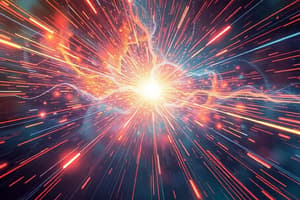Podcast
Questions and Answers
What is the main purpose of friction?
What is the main purpose of friction?
- To increase the speed of an object
- To decrease the weight of an object
- To enhance gravitational pull between objects
- To resist the motion of one object against another (correct)
What are the units of measurement for force according to Newton's second law?
What are the units of measurement for force according to Newton's second law?
- Meters per second squared (m/s²)
- Newtons (N) (correct)
- Kilograms (kg)
- Joules (J)
How does weight differ from mass?
How does weight differ from mass?
- Weight is expressed in kilograms, while mass is expressed in Newtons.
- Weight measures the force of gravity on an object, mass measures the amount of matter. (correct)
- Weight and mass are the same in every context.
- Weight is constant while mass varies.
What happens to the acceleration of an object if the mass is doubled while applying the same net force?
What happens to the acceleration of an object if the mass is doubled while applying the same net force?
What is the weight of a 60 kg person on the Moon, given that gravitational force is 1/6th of that on Earth?
What is the weight of a 60 kg person on the Moon, given that gravitational force is 1/6th of that on Earth?
Flashcards
What is friction?
What is friction?
Friction is a force that opposes the motion of an object in contact with a surface. It always acts in the opposite direction of motion.
What is weight?
What is weight?
Weight is the force of gravity acting on an object. It's influenced by the mass of the object and the gravitational acceleration of the planet or celestial body it's on.
What is inertia?
What is inertia?
Inertia is an object's resistance to changes in its motion. An object at rest stays at rest, and an object in motion stays in motion unless acted upon by an external force.
What does Newton's Second Law of Motion say?
What does Newton's Second Law of Motion say?
Signup and view all the flashcards
How do you use Newton's Second Law of Motion to solve problems?
How do you use Newton's Second Law of Motion to solve problems?
Signup and view all the flashcards
Study Notes
Forces and Newton's Laws
- Friction: A force opposing motion between surfaces. It acts opposite to motion. Types include sliding, rolling, static, and fluid friction. Friction depends on surface types and the force pressing the surfaces together.
Weight vs. Mass
- Weight: The force of gravity acting on an object.
- Mass: The amount of matter in an object.
- Difference: Weight is a force (measured in Newtons), while mass is a measure of matter (measured in kilograms).
Factors Affecting Gravity
- Gravity is not discussed in this text.
Newton's Laws
-
Newton's First Law (Inertia): An object at rest stays at rest, and an object in motion stays in motion with the same speed and in the same direction unless acted upon by an unbalanced force. Implies resistance to change in motion.
-
Newton's Second Law: Force equals mass times acceleration (F=ma).
- Units: Force (N), Mass (kg), Acceleration (m/s²).
- 1 Newton (N) = 1 kg*m/s².
- Solving for acceleration (a): a = F/m
- Solving for mass (m): m = F/a
- Practical Applications: Calculating acceleration given force and mass, or vice versa. Calculations given include:
- Acceleration of 3kg object with 12N force: 4 m/s²
- Acceleration of 6kg object with 12N force: 2 m/s²
- Mass with 16N force and 5m/s² acceleration: 3.2 kg
- Force needed to accelerate 66kg skier at 1m/s²: 66 N
-
Newton's Third Law (Action-Reaction): For every action, there is an equal and opposite reaction. (Not covered in this excerpt)
Force and Acceleration Examples
- A force of 10N is needed to accelerate a 20 kg object at 0.5 m/s².
- A weight of 60kg person on Earth experiences ≈ 600N (assuming Earth's gravity).
- The person's weight on the Moon is ≈ 1/6 its weight on Earth (100N): their mass stays the same (60 kg).
Balanced vs. Unbalanced Forces (Examples Missing)
- This section has example questions but lacks the solutions needed to generate proper study notes.
Studying That Suits You
Use AI to generate personalized quizzes and flashcards to suit your learning preferences.




